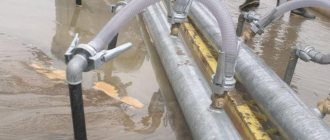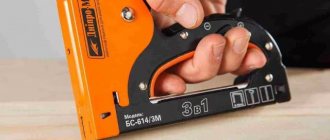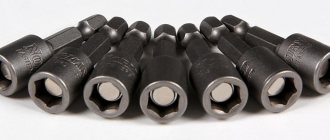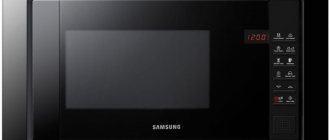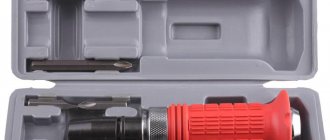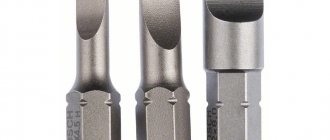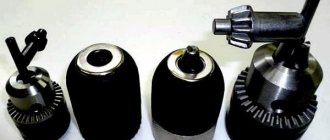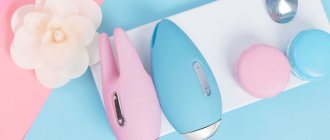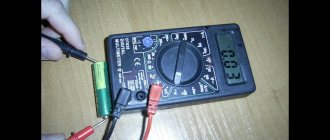Slotted bits
The very first screwdriver to be invented was a slotted screwdriver; it was invented in the 16th century. It was widespread during the Soviet period. Today, there are also types of screwdriver bits made for straight slots, but they are used less frequently. Such bits are designated by the letter S. This marking is placed on one of the edges of the bits.
The Latin letter S is an abbreviation for the English word slot, meaning “slit” or “slot.” There is also an alternative designation - slotted. This word when translated into Russian means “slotted”. There is always a number next to the letter indicating the width of the tip. In some cases, its thickness is additionally indicated.
The ratio of the width and thickness of the most common slotted bits:
| Width, mm | 2,0 | 2,5 | 3,0 | 3,5 | 4,0 | 4,5 | 5,0 | 5,5 | 6,0; 6,5; 7,0 | 8,0 | 9,0 |
| Thickness, mm | 0,3 — 0,4 | 0,4 | 0,5 | 0,5 — 0,6 | 0,6 — 0,8 | 0,6 | 0,8 | 0,8 — 1,0 | 1,0 — 1,2 | 1,2 — 1,6 | 1,4 — 1,6 |
Next, we will look at some types of bits for straight slots.
Classic straight bit
Width and thickness are the two main dimensions of a straight spline. In most cases, only the first parameter is specified. It varies from 3.0 to 9.0 mm. The second parameter is often not indicated, but its value can range from 0.5 to 1.6 mm. The peculiarity of this marking is due to the fact that the width and thickness have a standard ratio. The surface of the flat-slotted bits is protected from erosion and has increased hardness.
Bit with straight slot and TIN coating
These bits have a golden color because the surface of the bits is coated with titanium nitride as a result of the CVD chemical process. Thanks to this, the devices have a durable surface. Such nozzles may differ from each other only in width. This value ranges from 4.5 to 6.5 mm. The markings of the devices may also indicate their thickness. This value ranges from 0.6 to 1.2 mm.
Extended slotted bit
Thanks to the elongated part of the device, it is possible to carry out the necessary work more accurately. When used, the tip of this attachment is firmly placed in the head of the screw or screw. Using this bit it is convenient to perform small installation processes. A distinctive feature of these devices is the length of the nozzles, which ranges from 50 mm to 100 mm.
Does the color of the screw affect the choice of bit?
Of course, it is much more important to choose the right nozzle size than the color. However, this characteristic should also be taken into account to use optimal bits:
- PH bits are recommended for self-tapping screws on wood or black metal.
- PZ bits are more designed for yellow screws. In this case, a more reliable contact is achieved.
If we talk about the ratio of the sizes of the screws or self-tapping screws themselves, then the nozzles should be chosen according to the following system:
- PH1 is suitable for the smallest fasteners (in common parlance, seeds) ranging in size from 2.5 to 3 mm.
- PH2 is preferably used for products with a length of 3 to 5 mm.
- PH3 is suitable for larger 6mm screws.
- PH4 is practically not used, since fasteners longer than 6 mm can rarely be tightened with a screwdriver.
- PZ1 are used for self-tapping screws up to 3 mm.
- I use PZ2 when working with fasteners with a length of 3.5 to 4 mm.
- PZ3 is suitable for fixing longer screws from 4.5 to 5 mm.
Cross bits (Phillips)
The cross-shaped bat first appeared in the first half of the 20th century. This was facilitated by the fact that when using fasteners and slotted screwdrivers in the automotive industry, when assembling parts, they often slipped out of the heads of screws and screws, which led to damage to the varnished coating of the vehicle. Also, the threads of fasteners often broke due to the fact that torque limiters, which later began to be used in mechanical screwdrivers and screwdrivers, had not yet been invented.
All of these reasons contributed to the invention of the Phillips screw in 1933 by John Thompson. Three years later, the patent for this invention was acquired by Henry Phillips. This engineer refined the production technology and in 1937 invited Eugene Clark, who was a major manufacturer of metal products, to hold a competition to see who could tighten the screws the fastest.
Naturally, Henry Phillips won the competition. After this, a new type of attachment attracted the attention of US automakers, but World War II soon began. Therefore, the cross-head slot appeared in Europe, along with the supply of American military equipment.
The first cross-shaped nozzle was called "Phillips" in honor of Henry Phillips. Bits of this type are marked with the letters PH. They are followed by a number rigidly associated with the diameter of the external thread of the fastener. This standard is used for all types of Phillips bits.
Standard ratios between the number of the PH type cross bit and the external thread of the fastener:
| Bit number | 0 | 1 | 2 | 3 | 4 |
| Thread diameter, mm | less than 2.0 | 2,1 — 3,0 | 3,1 — 5,0 | 5,1 — 7,0 | more than 7.1 |
Classic cross bat PH
These nozzles differ in size, which range from 0 to 4. The most commonly used crosspiece is No. 2, as it allows you to work with metal and wooden materials. Large nozzles numbered 3 and 4 are used less frequently. They are most often used when repairing cars and large items.
Cross bit with PH slot and TIN coating
Titanium nitride is used to coat the nozzle. This is evidenced by the golden color of the bat. The nozzle can withstand heavy loads. The slot can be made in one of three sizes: PH 1, 2 or 3.
Long cross bit PH
An extended nozzle with a cross-shaped PH slot can be used for tightening fasteners in hard-to-reach places. Such devices are especially effective when unscrewing fasteners. Most often you can find nozzles with a length of 50, 70, 90, 110, 125, 150 mm. Available in three sizes PH 1, 2, 3.
Special types of bits and their purpose
In this block we will describe several more highly specialized types of bits, which differ from the standard in the shape of the working part.
Bits for nuts and bolts
These bits have a non-standard shape. The main difference is that the working part has a convex rather than convex working part. They literally fit onto the fastener and remove it by grasping it from the outside. To work with fasteners with a large diameter, you need to use fairly powerful screwdrivers.
With anti-vandal slot
These bits are often referred to as "snake eye" bits because they have a special head that fits the fork wrench.
Professional bits
This is a type of bit that has high strength, reliability and service life. They can tighten a larger number of fasteners, more than 400, while remaining in working condition. Often such consumables are also coated with protective materials, which saves them from corrosion and rapid wear.
This category includes torsion bits that are designed to work with impact screwdrivers. Its distinctive feature is the presence of a flexible insert that uses the principle of twisting.
Drywall bits
Drywall is a soft material, so it is very easy to force fasteners into it too much. For this reason, drywall bits have a stopper that will prevent the fastener from being screwed in too deeply.
Fork bits
This is a type of anti-vandal nozzle. They are made of very durable steel and have a long service life. These bits are similar to simple spline bits, but have a slot. There is also a consumable with a slot, which has three blades. This type of slot is called tri-wing. Its main purpose is to work with household appliances and appliances.
Magnetic and spring
Magnetic locking bits are very useful when working at heights or in hard to reach areas. The latches hold the bit in the adapter and prevent it from falling out. In addition, the nozzle is protected from slipping during operation.
Spring attachments make it possible to work with fasteners at an angle and in hard-to-reach places. The spring bends at different angles, even more than straight. In this case, rotation is well transmitted from the screwdriver to the fastener.
Cross bits (Pozidriv)
Later, specifically for the production of furniture and construction work, Philips Screw Company developed a new type of cross-head slot. It was named Pozidriv. This type of spline was patented in 1966. The bits for this slot are marked with the letters PZ. They are designed to work with wood or other similar materials that have a heterogeneous structure. At the same time, PH type bits are more suitable for working with metal.
A distinctive feature of the PZ system, in comparison with the PH, is that the edges of the working surfaces are located parallel to each other and are made of the same thickness along their entire length, and the slot itself is much deeper. This design feature prevents the bit from being pushed out when tightening the fastener. Thanks to this, a tighter contact is formed between the screw head and the bit, which reduces wear on the elements. In this case, there is no need to apply large axial forces when the tip is pressed onto the slot.
It must be remembered that when choosing a bit for tightening fasteners for a PZ slot, you must use a PZ type bit. If you use a PH type nozzle to screw products into a PZ slot, the surfaces will not be in close contact with each other, which will shorten the life of the nozzle.
Classic cross-shaped PZ bit with serrations
Additional knurls are a distinctive feature of PZ bits when compared to PH bits. The great strength of the devices allows them to withstand enormous loads. The sizes of this type of bit for a screwdriver can be PZ 1, PZ 2, PZ 3.
Phillips bit PZ with serrations and TIN coating
The protective coating of this nozzle is made on the basis of titanium nitride. It significantly increases the durability of the bat. This is also facilitated by the hardened steel used for its manufacture. All this together made it possible to create a nozzle with optimal hardness and endurance. There are three sizes of the fixture: PZ 1, PZ 2 and PZ 3.
Extended cross-shaped nozzle PZ
This nozzle is available in three sizes: PZ 1, PZ 2, PZ 3, and can be 50, 70, 90, 110, 125 and 150 mm long.
Material
Currently, a huge variety of materials are used in the manufacture of baseball bats. But in general, they are all divided into three main categories: aluminum, graphite and titanium bits, and wood bits.
Aluminum is lighter in weight, which improves projectile control and swing speed. The ball is knocked out with such a bat much further than with a bat made of any other metal. Having a high cost compared to bats made from other materials, the aluminum bat is durable and does not splinter or break. Aluminum bats come in different weights and from different alloys - aluminum with zinc, copper, magnesium. As a rule, light aluminum alloys are stronger.
The bat's light weight also contributes to a larger striking surface. You can increase both the length of the projectile and the diameter of the barrel, or “beater,” which makes hitting the ball much easier.
Aluminum and alloy bits typically come in single-ply and double-ply designs. Double-layer bats have greater strength and power, allowing you to hit the ball much further.
The development of new technologies and the use of modern materials has allowed manufacturers to produce lighter and stronger bats. Graphite and titanium are some of the main critical components of these technologies. Bats made from these materials have thinner walls than aluminum bats, reducing the weight of the bat and increasing the player's swing speed. Also, thanks to these materials, the strength and impact surface of the bat have increased.
The use of graphite and titanium has made it possible to further reduce vibration upon impact, which very often gives off an unpleasant tingling sensation in your hands at the moment when you strike not with the working area, but with any other area of the bat.
The wooden baseball bat is a classic. In Major League Baseball, only wooden bats are allowed. By the appearance of the structure of the fibers (their length, size, frequency) you can determine the age of the tree and its density. Wooden bats have a great variety of configurations and all sorts of tricks to achieve the best results when swinging and striking. But you should know that a bat made of wood has three main disadvantages: it cracks and breaks; its striking surface is smaller; Impact power is lower than that of metal counterparts.
The main tree species for making bats are white ash, maple, birch, hickory (hickory), and bamboo. Tree species can be combined to make hybrid or composite bats.
Hex bits (Hex)
Another, less popular, but often used is the hexagonal slot. This form of notch first appeared in 1910 and was called Hex socket. This phrase means internal hexagon. It was first used on the factory floors of the Allen Manufacturing Company. The letter H is used to mark these bits. The Hex system features a large amount of torque that can be applied to the head of the fastener as it is tightened. In this case, there is no possibility of damage to the nozzle and the slot breaking off.
The distance between the sides of the hex blade is the main characteristic that distinguishes these bits. If you take a 4 mm nozzle, it is perfect for screwing furniture confirmat. A so-called safe type of slot is also available. It is called Hex-Pin, which stands for protected hexagon. This slot is equipped with a special pin in the center. Its presence helps prevent unauthorized disassembly of the connection.
Classic hexagonal bat
These bits make it very convenient to work with the corresponding self-tapping screws and self-tapping screws, since they have a large area of contact with fasteners. They have been used in the United States for a long time, but their introduction in Russia occurred relatively recently. The sizes of these nozzles can vary from 1.5 to 10 mm.
Hexagonal shaped bit with hole inside
A reliable bit of this type is easy to use. During its use, a person does not need to exert much physical force. Thanks to the presence of the hole, the device does not slip off. The size of the nozzle ranges from 1.5 to 6 mm.
Extended hex bit
This attachment is marked with the Hex- symbol. She is rarely seen at work. Despite this, it has proven itself well, as it is practical and convenient. High quality steel is used to make this bat. Due to this, it has good strength. Its dimensions range from 3 to 8 mm, and the length of such attachments varies from 50 to 100 mm.
Hexagon and star
Such slots are less common. It’s more convenient to work with them: the bit holds the screw more tightly and you don’t need to put pressure on it.
Hex bit sizes are indicated in millimeters. The most popular is 4 mm, very often used in furniture production. Sprocket sizes are classified differently. There are from 1 to 100, but in practice less than 4 and more than 40 are rarely found.
Interestingly, these two varieties are interchangeable. Of course, if you tighten the hex spline tightly with an asterisk bat (especially the same one several times), the spline will break. So it's still better to use the right bat.
Star Bits (Torx)
Star-shaped nozzles are used in the mechanical engineering field and in the production of household appliances for tightening fasteners with the appropriate head shape. They are called Torx and are designated by the letters TX or T. Next to the letter is a number that indicates the size of the nozzle. It corresponds to the distance between the rays of a hexagonal star.
Torx was first used in 1967 by Textron in America. Today, different types of bits are used for this type of screwdriver. So, there is a vandal-proof version equipped with an internal hole. It is designated by the letters TR, which stands for Torx Tamper Resistant. Five-point bits called Torx Brigadier Pentahedron are also used.
Classic bit "Star" (Torx)
In European countries and the USA, the Torx nozzle is the most popular of all existing slot shapes. This is due to its high performance. This bit is distinguished by the presence of six edges, with the help of which contact with a screw or screw occurs.
The design feature of the nozzle improves adhesion to the surface of the fastener. Thanks to this, you do not need to exert much effort to create torque. The likelihood of the device slipping is also reduced, since the load is distributed across 6 edges at once. In turn, this reduces their wear. Consequently, the service life of the bit increases significantly. “Star” nozzles are available in different sizes. The most common models are from T8 to T40. However, there are also smaller bits.
Star bit Torx Plus
Torx Plus is different in that its sprocket has less sharp rays, which are also shorter. These types of screwdriver bits require the master to have increased precision when performing work. High-hardness steel is used for their manufacture. The sizes of these nozzles are T10 - T40.
Star bit with TIN coating
Thanks to the presence of a coating based on titanium nitride, the nozzle has increased wear resistance. Its surface is rough and adheres well to steel. The nozzle is also more durable because it is made of hard material. The nozzle is sold in sizes from T10 to T40.
Star bit with a hole inside
This bit is often used in assembly plants. When tightening the fastener, the bit fits tightly into the fastener. As a result, the reliability of the tightening process increases, for the implementation of which no special effort is required. Bit sizes range from T10 to T40.
Extended bit "Star"
This attachment is convenient to use when performing certain types of work. Its dimensions are the same: from T10 to T40, length can be from 50 mm to 100 mm.
Classification of bits by material and coating
Both soft and hard metals are used to produce bits. Their quality and service life directly depend on this. The following alloys are considered the most durable and high-quality:
- molybdenum and chromium;
- vanadium and chromium;
- molybdenum and vanadium;
- silicon-fire sinter.
In the case of steel bats, strength is increased by titanium coating. It is followed in terms of strength by coatings made of diamond, nickel or a tungsten-nickel alloy. At the same time, tungsten provides a margin of safety, and nickel protects against corrosion.
Square slotted bits (Robertson)
These attachments are specialized types of bits. In most cases, they are not used in conventional construction or renovation processes. The Robertson spline is one of the rarities and has a square section. Its full name is Robertson square. Nozzles of this shape are designated by the letter R.
Classic bat with four sides
Most often they are used during furniture assembly. These nozzles are available in 4 sizes: from No. 0 to No. 3.
Long bit with four edges
This attachment is not used very often. It is available in three sizes: No. 1,2 and 3 and can be from 50 to 70 mm long.
How to choose a quality bat
To work with a screwdriver quickly and efficiently, you need to understand how to choose a high-quality bit for your tool. Now we will describe what to focus on when choosing a consumable.
Basic criteria for choosing bits for a screwdriver
First of all, you need to understand what kind of material you will be working with. For example, twisting into wood is associated with certain loads, while metal is associated with completely different ones.
3 bit selection criteria:
- Material of manufacture. The service life of the consumable and its strength depend on this. If the bat does not have to withstand very high loads, R-7 - R-12 steel with chrome-vanadium protection will suffice. If you need increased stability, you should give preference to titanium-nitrium coated bits (they have a golden tint).
- Manufacturing technology. Bits can be milled or forged. Milling involves removing the top part, and during forging, the material is heated, after which it is given the required shape. Forged products have great strength.
- Hardness. Soft metal bits wear off faster but are suitable for use with hard fasteners. Solid nozzles have a longer service life, but also have increased fragility. The optimal hardness for bits is 58-60 HRC.
Bits with anti-vandal slot (Spanner head)
This slot is also called Snake-eye. In addition, it is also called a fork head. To mark bits with such a slot, the letters SP are used.
Classic bat "Fork"
High-quality steel is used in the manufacture of these nozzles. Thanks to it, the bits are characterized by increased strength and long-lasting durability. This attachment resembles a flat slotted bit that has a slot in the middle. The bat is available in 4 sizes, Gr. 4, 6, 8, 10.
Extended bit "Fork"
Available in 4 sizes and lengths from 50mm to 100mm.
Baseball bat rating
You probably looked at reviews before purchasing sports equipment. Pay attention to the following popular models that are chosen by most users.
Start UP "R Bull"
It features a stylish black color and bright stickers. Its price is $8.
The Legioners Smithys Good Night
An option for children, which is also ideal for training the fair sex. It has a diameter of seven centimeters and a length of 50 cm. You can buy it for fourteen dollars.
Easton YBB19OM11
The aluminum bat has a stylish yellow and black body. The option is not cheap - $115.
V76 Concept-21
The model is made of wood. It has a length of 53 centimeters. Costs about four dollars and is suitable for beginners.
Eagle Magnum C243-34
Bat for professional players. Composite wood species were used for its manufacture. Price – $135.
Tri-Wing Splined Bits - Three Blade
When marking these attachments, the letters TW are used. A distinctive feature of these bits is the presence of 3 blades on the tip. They are used in the assembly of household appliances and electronics. They are also used in the aerospace industry. These bits first appeared in 1958 and were invented by Philips Screw Company. The size is designated by the letters Gr and can have indicators from Gr.1 to Gr.6.
Is it worth buying bit sets?
A set of bits is an excellent purchase for those who often use a screwdriver and perform various tasks with it. Technicians often need different sizes or types of bits, so it's handy to keep them on hand in one place. You can choose a set with a different number of bits, ranging from the most basic attachments to large sets that include highly specialized bits.
It is important to always be responsible when choosing bits, and then they will justify the costs with their quality.
Adapter for screwdriver
Adapters are used to change bits as quickly as possible, especially if they have different tails. Particularly popular are adapters with a holder, as well as other special ones: elongated, angled, hinged or flexible.
By choosing the right bit for your screwdriver, screws, nuts or other fasteners, you can use it for a long time and not change it immediately after starting work.
Source: pro-instrument.com
Self-tapping screws for PH and PZ
How PH self-tapping screws differ from PZ is something every craftsman who does housework needs to know. Not to mention the installers who cover the balconies.
Most self-tapping screws have a cross head. There are two types of cross holes in the self-tapping screw PH and PZ.
How to understand which screw needs which bit?
The self-tapping screw can be small or large, with a hidden head or an external one. There is an instruction on the head of any self-tapping screw.
If there is a regular cross on the head, then you need a Ph bit.
If the cross has the characteristic four notches at 45°, then this screw needs a Pz bit.
Design or what are torsion bits
In addition to the material, the service life of the equipment is affected by its design.
It comes in two types: rigid and flexible. Externally, the bits look almost the same - the only difference can be in the colored insert on the leg of the latter. But now they produce products without it. Hard bat
It is simply a piece of metal of a certain shape. It transmits torque from the gearbox to the fastener. When a self-tapping screw stops abruptly in a hard material, a strong impact occurs, which leads to knocking down of the edges in the head and nozzle or breakage of the bit.
Torsion bit
equipped with a flexible insert - a shaft capable of twisting and unwinding along the axis. Such bits are well suited for impact screwdrivers when you need to screw a long self-tapping screw into a dense material or, conversely, unscrew an old fastener. The attachment transfers tangential impact well from the power tool, and instead of slipping out of the grooves, it acts on the slots in the head, providing rotation. Impact bits last much longer than regular bits.
Torsion bit.
Which bits don’t float for Shuriks?
Well, “instantly”.
Yeah.. About a hundred self-tapping screws (black, 75 for wood). For comparison, Bosch (USA) lives for years under such operating conditions. The bits are still alive
Strange. I have one Witte bit that survived an apartment in the old building (there are joists + plywood in 2 layers) for about 160 meters and died only because they turned on the impact mode in the screwdriver, it simply split. I don’t remember what episode it was.
M/1914 wrote: yeah... About a hundred self-tapping screws (black, 75 for wood).
Some kind of bullshit. Maybe a leftist? Titanium coated ones last quite a long time.
Maybe, of course, he’s a leftist, but the bat itself is beautiful, the inscriptions are written well... And so is the packaging. I remember that the end that was inserted into the holder was “twisted” with a rosette (the scratch apparently came from the cutter). When I get to the store I’ll take a photo.. + I have one at home right now, that PH1 - the edges are thoroughly licked off..
M/1914 wrote: I have one at home right now, that PH1 - the edges are thoroughly licked off..
If it's not a secret, what did you play on her?
M/1914 wrote: For comparison, Bosch (USA) lives for years under such operating conditions.
Bosch USA is practically a legend. They are not available in stores.
The Chinese made a mistake when they wrote. This often happens to Asians. For them, the Latin alphabet is like the Chinese alphabet for us.
Alex___dr wrote: If it's not a secret, what did you play to her?
Are you implying that maybe you used bits to turn the fasteners that were not their size? Those. for example, with a bat RN1 we turned the screws RN2.
I answer point by point:
- If the bit is PH1, then I use it to tighten the screws under PH1, very rarely PZ (when there is no PZ bit)
- Bosch-USA may be a legend among you, but I bought a lot of them in my time - I still have a couple of packs lying around, and we still have them in stores. If you don't like the Bosch comparison, let it be Wurth. Wurth's resource is no less than Boshevsky's. This evening I will try to post a photo of that same witte PH1.
ADM05 wrote: The Chinese made a mistake when they wrote. This often happens to Asians. For them, the Latin alphabet is like the Chinese alphabet for us.
I took a closer look - “Made in Germany LA”. In this case, the last two letters are in a smaller font, but capitalized. And printed at an angle. Complete scam
ADM05 wrote: Are Witte bits sold in your city?
I know only one place where they are sold in Novosibirsk
sledoput wrote: I took a closer look - “Made in Germany LA”.
on 50mm bits there is a postscript EB (if my eyes didn’t deceive me, I couldn’t find a magnifying glass). The postscript is made as if below the main line, maybe this is some kind of classification
ADM05 wrote: Bosch-USA is practically a legend. They are not available in stores.
There is one on eBay, and you can always immediately look for Magna, it is also available.
Has anyone seen Hammer bits for sale? Am I the only one who thinks they look very good?
lomaster Well, external similarity is not a guarantee of bit resistance.
Looks like another NoName, with coloring and logo it looks like a green Bosch
lomaster wrote: Has anyone seen Hammer bits for sale? Am I the only one who thinks they look very similar to good ones?
I would risk taking unfamiliar bits with this name only after a very authoritative recommendation
M/1914 wrote: yeah... About a hundred self-tapping screws (black, 75 for wood). For comparison, Bosch (USA) lives for years under such operating conditions. The bits are still alive
Black self-tapping screws for Ph? And did you use them for wood? They are knee-mounted, under drywall. Then the bits must be used corresponding to the torsion zone. Maybe they will still live under such extreme conditions. In general, for wood, self-tapping screws with Pz, Torx, hexagons, with appropriate hardening.
lomaster wrote: Has anyone seen Hammer bits for sale? Am I the only one who thinks they look very similar to good ones?
. IMHO for this money it is better to take the proven quality Bison Expert or Whirlpower (Scrub). Our Zubr Expert costs on average 60 rubles for 2 50 mm bits, i.e. for 8 (as in your set) it turns out to be 240 rubles, but they are 50 mm!. Whirlpower costs an average of 20 rubles per bat if you buy in packs of 10 pieces. And if you need something of better quality, then here it is: . The bits are most likely still made in Germany, the adapter in the Czech Republic. IMHO, here the quality already corresponds to the price. The Wera Rapidator is an indispensable tool when you need to work with one hand.
lomaster wrote: Has anyone seen Hammer bits for sale? Am I the only one who thinks they look very similar to good ones?
Is the yellow paint a type of sumeregano-hard coating designed for millions of twists?
